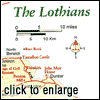|
East Lothian
Dunbar and West
Near the shoulder where the Firth of Forth meets the
North Sea, the A1087 off the A1 leads to Dunbar, the first major town after Berwick-upon-Tweed
across the border. English aggressors often targeted Dunbar as they moved towards
the capital and it was severely treated during successive invasions.
 A popular seaside resort during Victorian times, the cobbled
harbour with its piles of orange fish nets and seaweed-draped lobster creels is an
interesting place to explore. King Malcolm Canmore installed his cousin, the deposed
Earl of Northumbria, here at Dunbar Castle, now an impressive stone pile at the harbour
mouth, in the eleventh century, making him the Earl of Dunbar. There is a modern
swimming and leisure complex overlooking the harbour and most useful on wet or chilly
days. A popular seaside resort during Victorian times, the cobbled
harbour with its piles of orange fish nets and seaweed-draped lobster creels is an
interesting place to explore. King Malcolm Canmore installed his cousin, the deposed
Earl of Northumbria, here at Dunbar Castle, now an impressive stone pile at the harbour
mouth, in the eleventh century, making him the Earl of Dunbar. There is a modern
swimming and leisure complex overlooking the harbour and most useful on wet or chilly
days.
Immediately west of Dunbar, overlooking Belhaven Bay
and the mouth of the Tyne, is John Muir Country Park taking its name from the founder
of the American National Parks system. John Muir was born here in 1838, and it is
possible to visit his house in the High Street restored in period style. He later
became associated with wildernesses such as Yosemite National Park.
Following the coast involves turning right onto the
A198 signposted for North Berwick. About a mile up that road, turn left into the
village of Tyninghame following the signs for Preston Mill which is another mile
beyond. Restored by the National Trust for Scotland to working order, its unusual
form and ruddy-red building materials are striking.
Back en-route to the coast you come upon Whitekirk,
built in the ubiquitous red sandstone of these parts, which must have been covered
in white harling in previous periods to give the church its name. Its history dates
back to the sixth century when it was famed for a healing well which is no longer
in evidence. The tithe barn behind the church is one of the oldest of its type still
standing.
Around the bend from the village you find Whitekirk
Golf Club, a pay and play facility with an exceptional restaurant that is open to
all. The course is rather tough unless you are accurate at hitting small greens but
the views are lavish.
 For those seeking dramatic landscapes without the golf, the
site of Tantallon Castle, a few miles along the A198, will not disappoint. Pull over
on this quiet approach road to appreciate its strawberry red massive bulk set against
the backdrop of the Forth Estuary. Competing for your attention, offshore, is the
great guano-covered volcanic plug of Bass Rock. For those seeking dramatic landscapes without the golf, the
site of Tantallon Castle, a few miles along the A198, will not disappoint. Pull over
on this quiet approach road to appreciate its strawberry red massive bulk set against
the backdrop of the Forth Estuary. Competing for your attention, offshore, is the
great guano-covered volcanic plug of Bass Rock.
The ponderous, square citadel of Tantallon Castle
with its 50ft (15.25m) high curtain walls stands precariously at the edge of an abrupt
cliff-face. It was the Red Douglases who dwelt within its walls, actually renting
it from the Earls of Fife and keeping a well-trained army to maintain their independence.
From the car park, it is a pleasant walk to the castle frontage revealing more of
the its defences in the form of a series of earthworks and ditches. These were installed
to protect against James V's cannon when he laid siege here in 1529.
The Bass Rock, one of several pieces of volcanic debris
scattered around the coastal Lothians, can be visited seasonally from North Berwick.
A small, open boat sails round the rock to look at the breeding colonies of gannets,
guillemots and puffins. Special permission is needed to land.
North Berwick
 The seaside resort of North Berwick surrounds another volcanic
plug called the North Berwick Law, a 614ft (190m) mass that towers above the town.
It can be appreciated from the High Street and Law Street, which you take to access
the path. At the top, after a steep but short climb, there are wide views of the
Lothian coastline with its groups of little islands, no more than perches for shags
and cormorants. You can see over the Forth to Fife, south to the Lammermuirs and
to the volcanic debris scattered throughout the area such as the nearby Bass Rock
or further west, Arthur's Seat and the Braid Hills of Edinburgh. The seaside resort of North Berwick surrounds another volcanic
plug called the North Berwick Law, a 614ft (190m) mass that towers above the town.
It can be appreciated from the High Street and Law Street, which you take to access
the path. At the top, after a steep but short climb, there are wide views of the
Lothian coastline with its groups of little islands, no more than perches for shags
and cormorants. You can see over the Forth to Fife, south to the Lammermuirs and
to the volcanic debris scattered throughout the area such as the nearby Bass Rock
or further west, Arthur's Seat and the Braid Hills of Edinburgh.
On the Law itself, caged in a spiky iron fence, is
a set of whale's jaw bones rather gruesomely arranged to form an arch which commemorates
this area's heavy involvement in the whaling industry.
An 'Auld Kirk', in North Berwick, now a ruin, stands
beside the harbour, a central site in a peculiar story that is often told about these
parts. James VI had almost been lost at sea just off North Berwick when returning
to Edinburgh from Denmark with his 15-year-old bride.
During the storm James thought he saw a small craft
being navigated by three hares, a common disguise for witches. Suspecting a witch's
coven to be the cause of the near disaster, he later visited North Berwick with a
party of armed followers and secretly observed a large gathering of witches performing
around the old parish church near the harbour.
At its centre was his cousin, Francis Earl of Bothwell,
a known dabbler in the black arts and a perpetual pain in James' side. Disguised
as the devil, Bothwell was having his followers kiss his rear when the king and his
party pounced, rounding up most of the revellers. The ring-leader, Bothwell, escaped.
There is a small museum in town situated in a former
school with displays on natural history, archaeology and life in this area. One of
the best eating here must be the Joypur Indian Restaurant at 114 High Street, North
Berwick, Tel: 01620 895649 for the most authentic cooking. North Berwick High Street
has several stores to explore and cafes to relax in. Thistles is good for gifts while,
next door, the Sugar Mountain offers home-made tablet, Vanilla Fudge and Boiled Sweets.
Dirleton
Following the A198 coast road west, the village of
Dirleton is delightful to look upon even though there is little to visit apart from
an ancient square of cottages and the skeleton of a castle. Dirleton Castle cannot
be seen from the village square, enclosed as it is by trees, but you can get an admirable
view of its rear from the by-pass, should you have missed the turning into Dirleton.
At one time, huge circular towers dominated the landward
aspect of this fortification while the main block at the south-west corner stood
very much as it is. The warm yellow and ochre stones were intricately placed upon
an igneous outcrop of rock, creating a high strong-hold.
The castle was taken by Edward I in 1298 and ravaged
by General Monk as he cut his way through Scotland in the 1650s. If the lawn reminds
you of a bowling green, that is precisely what it was in the seventeenth century.
The beehive shaped dovecote in the grounds offered shelter for pigeons in the form
of 1,100 nesting holes. The birds were usually destined for the winter pot.
Gullane and Aberlady
The town of Gullane further along the coast simply
oozes golf. If you pull up and sit a while in the main street you will soon sense
this. There is a small museum on West Links Road illustrating the area's golfing
heritage. Gullane is home to Muirfield or the Honourable Company of Edinburgh Golfers,
a venue for the British Open though its entrance is not easy to find and unless you
have booked well in advance, a tee time is equally obscure. Fear not as there are
four other 18-hole courses in this little town.
The shore-line from Gullane Bay to Aberlady consists
of high dunes that offer refuge for wildlife and nature-lovers alike. Aberlady Bay
was the first area in Britain to be declared a Local Nature Reserve in 1952 and has
become a valuable site for all manner of ducks, divers and grebes. Access is from
the car park at Gullane Links or by crossing the narrow wooden bridge just off the
road beyond the golf courses between Gullane and Aberlady. Here also are the remains
of Luffness Castle, a sixteenth century fortress with a thirteenth century keep,
opened by appointment only.
Aberlady is a charming, pantile-roofed village that
straddles the main route. Inland is the antiquated town of Haddington, now quite
a large and thriving community that serves the prosperous agricultural interior of
East Lothian. Over 130 buildings in Haddington are listed as being either architecturally
or historically interesting.
Further in towards the Lammermuirs, following country
roads such as the B6355, the seventeenth century village of Gifford lies in a dip
below sheep-dotted hills. The village is attractive in an austere kind of way with
the village Kirk at one end, the Mercat Cross and Square at the other and a line
of frugal old dwelling houses lining its main thoroughfare. There is an excellent
9-hole golf course just south of the village and another, Castle Park, a few miles
east and well signposted.
Prestonpans and Musselburgh
 Returning to the coast and progressing towards Edinburgh,
there is a more industrial characteristic to the landscape and buildings. Prestongrange
Mining Museum near Prestonpans tells the story of 800 years of mining in the area
and includes steam engine exhibitions, documents and artefacts of the industry. Returning to the coast and progressing towards Edinburgh,
there is a more industrial characteristic to the landscape and buildings. Prestongrange
Mining Museum near Prestonpans tells the story of 800 years of mining in the area
and includes steam engine exhibitions, documents and artefacts of the industry.
Prestonpans gained its name from the enterprise of
obtaining salt from great open-air pans, but its fame came later in 1745 when Bonnie
Prince Charlie gave the Westminster government one of its greatest shocks and put
Scotland back in control of the Scots. Charles was in command of Edinburgh within
four weeks of his initial landing in the country. At Prestonpans, it was dawn on
a bright September morning when the Highlanders descended on the Hanovarian camp
to find its General Cope having a lie-in. The battle of Prestonpans lasted little
more than 15 minutes with most of the government troops trapped against a mile-long
wall at Prestongrange House. The wall still stands although little evidence of the
battlefield remains.
Musselburgh is now by-passed by the upgraded A1 linking
with the Edinburgh City Bypass system though until recently it took most of the A1
traffic travelling north and south. The race-course at the east side of town is the
oldest in Scotland and the golf course it surrounds is one of the first where James
IV and James VI are said to have played. The rest of the town centre is uninspiring
although the harbour area is quite pleasant.
|




